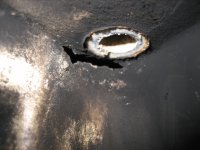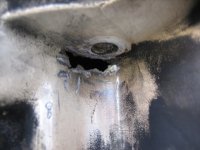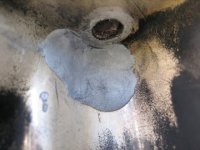timflan
Member
- Joined
- May 16, 2006
- Messages
- 548
- Reaction score
- 0
- C Dory Year
- 2005
- C Dory Model
- 22 Cruiser
- Vessel Name
- Two Lucky Fish +1
Anybody remember WAY back in 2007 when I had this problem?
http://www.c-brats.com/viewtopic.php?p=84415&sid=a98d5144774072575dc187f2796fb151
Documented the ultimate solution at Navagear, as well:
http://www.navagear.com/2007/11/01/my-johnsons-fixed/
In a nutshell, I had corrosion of the Engine Holder, the topmost of three large aluminum castings that constitute the midsection of the motor.
Well guess what? It looks like the Oil Pan casting (the middle one) has suffered a similar fate, and it might even explain the "pinging"/"knocking"/"rattling" sound I've been experiencing since late 2010. (Discussed here: http://www.c-brats.com/viewtopic.php?t=15804)
Looks like another $2000 repair, probably! That's what the first one cost.
Pictures...
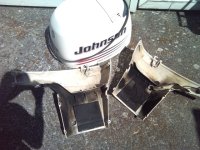
WOW! What's will all the black soot on the lower portion of the engine housing? Also notice the heat damage on the port-side cover...that crackley-looking foam insulation? Weird, eh?
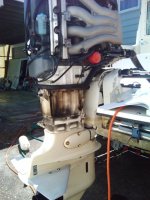
Starboard side of the engine midsection has some soot, but it's not all the bad. In defense of Jacobsen's, who opened this up most recently and didn't notice anything unusual, this is the side you normally work on.
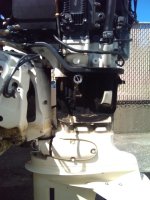
But check out the port side...wow! That can't be good. I'm going to guess that the problem is on this side. Let's go in for a closer look and see if we can spot anything obvious.

BINGO! Corrosion resulting in an internal exhaust leak. Result: Soot and "rattling" engine noise as RPMs increase. Also some heat damage to foam, rubber, and even the fiberglass engine housing.
http://www.c-brats.com/viewtopic.php?p=84415&sid=a98d5144774072575dc187f2796fb151
Documented the ultimate solution at Navagear, as well:
http://www.navagear.com/2007/11/01/my-johnsons-fixed/
In a nutshell, I had corrosion of the Engine Holder, the topmost of three large aluminum castings that constitute the midsection of the motor.
Well guess what? It looks like the Oil Pan casting (the middle one) has suffered a similar fate, and it might even explain the "pinging"/"knocking"/"rattling" sound I've been experiencing since late 2010. (Discussed here: http://www.c-brats.com/viewtopic.php?t=15804)
Looks like another $2000 repair, probably! That's what the first one cost.
Pictures...

WOW! What's will all the black soot on the lower portion of the engine housing? Also notice the heat damage on the port-side cover...that crackley-looking foam insulation? Weird, eh?

Starboard side of the engine midsection has some soot, but it's not all the bad. In defense of Jacobsen's, who opened this up most recently and didn't notice anything unusual, this is the side you normally work on.

But check out the port side...wow! That can't be good. I'm going to guess that the problem is on this side. Let's go in for a closer look and see if we can spot anything obvious.

BINGO! Corrosion resulting in an internal exhaust leak. Result: Soot and "rattling" engine noise as RPMs increase. Also some heat damage to foam, rubber, and even the fiberglass engine housing.

